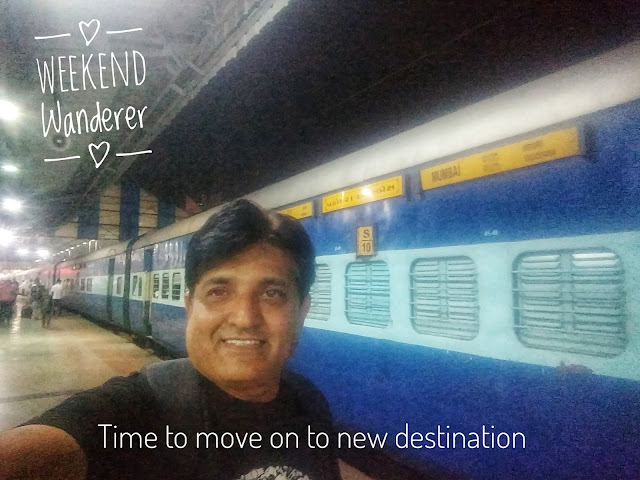This is how it began.....
It all started during my trip to Jodhpur (you can read from this link about my Jodhpur Series) last month, when a co passenger in the train dropped this name Champaner near vadodara, a sucker that I am for any new off beat destination I was kind of all ears to him. I could see the joy on his face as he was describing the place to me.
Sir this place was lost to people for more than 500 years !
You must see this wonderful confluence of Islamic, Hindu and Jain culture in the construction of these monuments and
above all this Champaner was declared as UNESCO world heritage site !
It was then and there I knew that I won't be able to sleep peacefully if I don't visit this place. Well I asked few of my friends if they could join me but every one was busy , Friday night I decided that I'm going what may come , so I packed my backpack which consists of bare necessities and of course my love my camera and I was off to Mumbai central station to catch late night Vadodara Express which departs at 11.40 to Vadodara.
 |
| All set to go on a night train to Vadodara |
Due to unreserved journey I had tough time managing to sleep and when I was all set to go to sleep Vadodara Station has arrived. It was 6:30 am when I reached Vadodara station. I quickly had khaman for breakfast at the station and then moved on to the Vadodara Central bus station which is very near to the Railway station.
 |
| Vadodara Central Bus Station (Pic source internet) |
Catching bus from ST stand are the real challenge, Though I enquired at the bus counter for the bus to Champaner I was told to take pavagadh bus from platform 16, Upon reaching the bus platform 16 when I saw the name pavagadh I asked the conductor whether this bus go to Champaner he said no, but you go from there to Champaner, so all confusion.
 |
| Platform no 16 at Vadodara Central Station( Pic source internet) |
Just then I saw a Rajasthan roadway bus and people jumped from the bus in which I was sitting to the Rajasthan roadways bus going to pavagadh, I too jumped and got in it. When I asked for the ticket to Pavagadh ,the conductor told me that this bus will drop me to Halol and from there I'll have to take an auto or bus to Pavagadh. I was like Hey Bhagwan, Meri maddat karo. Anyways this journey to Halol lasted around an hour and luckily I found a bus going to Pavagadh from there. This time I didn't take a chance and kept the GPS On, on my phone and as soon as I read Champaner I told the bus guy to stop he said Arre saheb, Bus stand 1 min hi door hai . So I quitely sat down and indeed realised that the Pavagadh ST bus station is just opposite the Champaner World heritage.
 |
| Pavagadh ST bus Station( Pic source internet) |
See the irony that Vadodara station have this large poster in their waiting room and yet the locals are unaware of this treasure in their back yard.
 |
| Poster at Vadodara Waiting Room |
At last this topsy turvy journey of mine came to an end and I was all set to step into the world of Ancient era of UNESCO World heritage site of Champaner. So what is this Champaner all about well here is little info you can use.
Champaner-Pavagadh Archaeological Park
It is a concentration of largely unexcavated archaeological, historic and living cultural heritage properties cradled in an impressive landscape which includes prehistoric (chalcolithic) sites, a hill fortress of an early Hindu capital, and remains of the 16th-century capital of the state of Gujarat. The site also includes, among other vestiges, fortifications, palaces, religious buildings, residential precincts, agricultural structures and water installations, from the 8th to 14th centuries. The Kalikamata Temple on top of Pavagadh Hill is considered to be an important shrine, attracting large numbers of pilgrims throughout the year. The site is the only complete and unchanged Islamic pre-Mughal city.
Justification for it been a World Heritage site
Criterion (iii): The Champaner-Pavagadh Archaeological Park with its ancient Hindu architecture, temples and special water retaining installations together with its religious, military and agricultural structures, dating back to the regional Capital City built by Mehmud Begda in the 16th century, represents cultures which have disappeared.
Criterion (iv): The structures represent a perfect blend of Hindu-Moslem architecture, mainly in the Great Mosque (Jami Masjid), which was a model for later mosque architecture in India. This special style comes from the significant period of regional sultanates.
Criterion (v): The Champaner-Pavagadh Archaeological Park is an outstanding example of a very short living Capital, making the best use of its setting, topography and natural features. It is quite vulnerable due to abandonment, forest takeover and modern life.
Criterion (vi): The Champaner-Pavagadh Archaeological Park place of worship and continuous pilgrimage for Hindu believers.
Aren't you excited like me to know the history and explore the grandeur of the past era consisting of some of the amazing Mosques,Jain Temples and cenotaphs.
Well then stay tuned till my next blog on amazing Shaher ki Masjid.
 |
| Thank you |






































